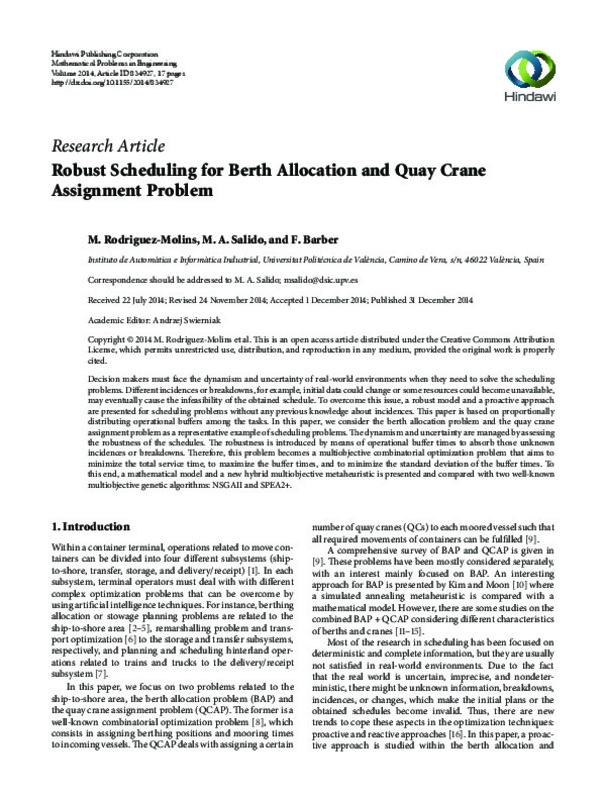Imai, A., Chen, H. C., Nishimura, E., & Papadimitriou, S. (2008). The simultaneous berth and quay crane allocation problem. Transportation Research Part E: Logistics and Transportation Review, 44(5), 900-920. doi:10.1016/j.tre.2007.03.003
Hu, Q.-M., Hu, Z.-H., & Du, Y. (2014). Berth and quay-crane allocation problem considering fuel consumption and emissions from vessels. Computers & Industrial Engineering, 70, 1-10. doi:10.1016/j.cie.2014.01.003
Salido, M. A., Rodriguez-Molins, M., & Barber, F. (2011). Integrated intelligent techniques for remarshaling and berthing in maritime terminals. Advanced Engineering Informatics, 25(3), 435-451. doi:10.1016/j.aei.2010.10.001
[+]
Imai, A., Chen, H. C., Nishimura, E., & Papadimitriou, S. (2008). The simultaneous berth and quay crane allocation problem. Transportation Research Part E: Logistics and Transportation Review, 44(5), 900-920. doi:10.1016/j.tre.2007.03.003
Hu, Q.-M., Hu, Z.-H., & Du, Y. (2014). Berth and quay-crane allocation problem considering fuel consumption and emissions from vessels. Computers & Industrial Engineering, 70, 1-10. doi:10.1016/j.cie.2014.01.003
Salido, M. A., Rodriguez-Molins, M., & Barber, F. (2011). Integrated intelligent techniques for remarshaling and berthing in maritime terminals. Advanced Engineering Informatics, 25(3), 435-451. doi:10.1016/j.aei.2010.10.001
Rodriguez-Molins, M., Salido, M. A., & Barber, F. (2013). A GRASP-based metaheuristic for the Berth Allocation Problem and the Quay Crane Assignment Problem by managing vessel cargo holds. Applied Intelligence, 40(2), 273-290. doi:10.1007/s10489-013-0462-4
Stahlbock, R., & Voß, S. (2007). Operations research at container terminals: a literature update. OR Spectrum, 30(1), 1-52. doi:10.1007/s00291-007-0100-9
Lim, A. (1998). The berth planning problem. Operations Research Letters, 22(2-3), 105-110. doi:10.1016/s0167-6377(98)00010-8
Bierwirth, C., & Meisel, F. (2010). A survey of berth allocation and quay crane scheduling problems in container terminals. European Journal of Operational Research, 202(3), 615-627. doi:10.1016/j.ejor.2009.05.031
Kim, K. H., & Moon, K. C. (2003). Berth scheduling by simulated annealing. Transportation Research Part B: Methodological, 37(6), 541-560. doi:10.1016/s0191-2615(02)00027-9
Giallombardo, G., Moccia, L., Salani, M., & Vacca, I. (2010). Modeling and solving the Tactical Berth Allocation Problem. Transportation Research Part B: Methodological, 44(2), 232-245. doi:10.1016/j.trb.2009.07.003
Liang, C., Guo, J., & Yang, Y. (2009). Multi-objective hybrid genetic algorithm for quay crane dynamic assignment in berth allocation planning. Journal of Intelligent Manufacturing, 22(3), 471-479. doi:10.1007/s10845-009-0304-8
Diabat, A., & Theodorou, E. (2014). An Integrated Quay Crane Assignment and Scheduling Problem. Computers & Industrial Engineering, 73, 115-123. doi:10.1016/j.cie.2013.12.012
Park, Y.-M., & Kim, K. H. (2003). A scheduling method for Berth and Quay cranes. OR Spectrum, 25(1), 1-23. doi:10.1007/s00291-002-0109-z
Zhang, C., Zheng, L., Zhang, Z., Shi, L., & Armstrong, A. J. (2010). The allocation of berths and quay cranes by using a sub-gradient optimization technique. Computers & Industrial Engineering, 58(1), 40-50. doi:10.1016/j.cie.2009.08.002
Lambrechts, O., Demeulemeester, E., & Herroelen, W. (2007). Proactive and reactive strategies for resource-constrained project scheduling with uncertain resource availabilities. Journal of Scheduling, 11(2), 121-136. doi:10.1007/s10951-007-0021-0
Hendriks, M., Laumanns, M., Lefeber, E., & Udding, J. T. (2010). Robust cyclic berth planning of container vessels. OR Spectrum, 32(3), 501-517. doi:10.1007/s00291-010-0198-z
Han, X., Lu, Z., & Xi, L. (2010). A proactive approach for simultaneous berth and quay crane scheduling problem with stochastic arrival and handling time. European Journal of Operational Research, 207(3), 1327-1340. doi:10.1016/j.ejor.2010.07.018
Xu, Y., Chen, Q., & Quan, X. (2011). Robust berth scheduling with uncertain vessel delay and handling time. Annals of Operations Research, 192(1), 123-140. doi:10.1007/s10479-010-0820-0
Zhen, L., & Chang, D.-F. (2012). A bi-objective model for robust berth allocation scheduling. Computers & Industrial Engineering, 63(1), 262-273. doi:10.1016/j.cie.2012.03.003
Blum, C., Puchinger, J., Raidl, G. R., & Roli, A. (2011). Hybrid metaheuristics in combinatorial optimization: A survey. Applied Soft Computing, 11(6), 4135-4151. doi:10.1016/j.asoc.2011.02.032
Ehrgott, M., & Gandibleux, X. (2008). Hybrid Metaheuristics for Multi-objective Combinatorial Optimization. Studies in Computational Intelligence, 221-259. doi:10.1007/978-3-540-78295-7_8
Hanafi, R., & Kozan, E. (2014). A hybrid constructive heuristic and simulated annealing for railway crew scheduling. Computers & Industrial Engineering, 70, 11-19. doi:10.1016/j.cie.2014.01.002
Deb, K., Pratap, A., Agarwal, S., & Meyarivan, T. (2002). A fast and elitist multiobjective genetic algorithm: NSGA-II. IEEE Transactions on Evolutionary Computation, 6(2), 182-197. doi:10.1109/4235.996017
Kim, M., Hiroyasu, T., Miki, M., & Watanabe, S. (2004). SPEA2+: Improving the Performance of the Strength Pareto Evolutionary Algorithm 2. Parallel Problem Solving from Nature - PPSN VIII, 742-751. doi:10.1007/978-3-540-30217-9_75
Rodriguez-Molins, M., Ingolotti, L., Barber, F., Salido, M. A., Sierra, M. R., & Puente, J. (2014). A genetic algorithm for robust berth allocation and quay crane assignment. Progress in Artificial Intelligence, 2(4), 177-192. doi:10.1007/s13748-014-0056-3
Zhou, A., Qu, B.-Y., Li, H., Zhao, S.-Z., Suganthan, P. N., & Zhang, Q. (2011). Multiobjective evolutionary algorithms: A survey of the state of the art. Swarm and Evolutionary Computation, 1(1), 32-49. doi:10.1016/j.swevo.2011.03.001
Bandyopadhyay, S., Saha, S., Maulik, U., & Deb, K. (2008). A Simulated Annealing-Based Multiobjective Optimization Algorithm: AMOSA. IEEE Transactions on Evolutionary Computation, 12(3), 269-283. doi:10.1109/tevc.2007.900837
While, L., Bradstreet, L., & Barone, L. (2012). A Fast Way of Calculating Exact Hypervolumes. IEEE Transactions on Evolutionary Computation, 16(1), 86-95. doi:10.1109/tevc.2010.2077298
[-]









